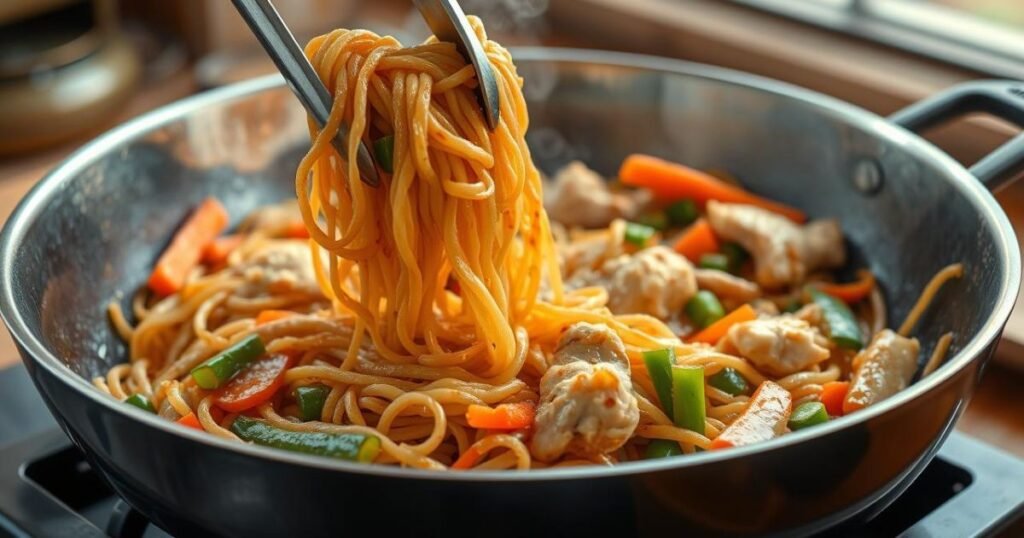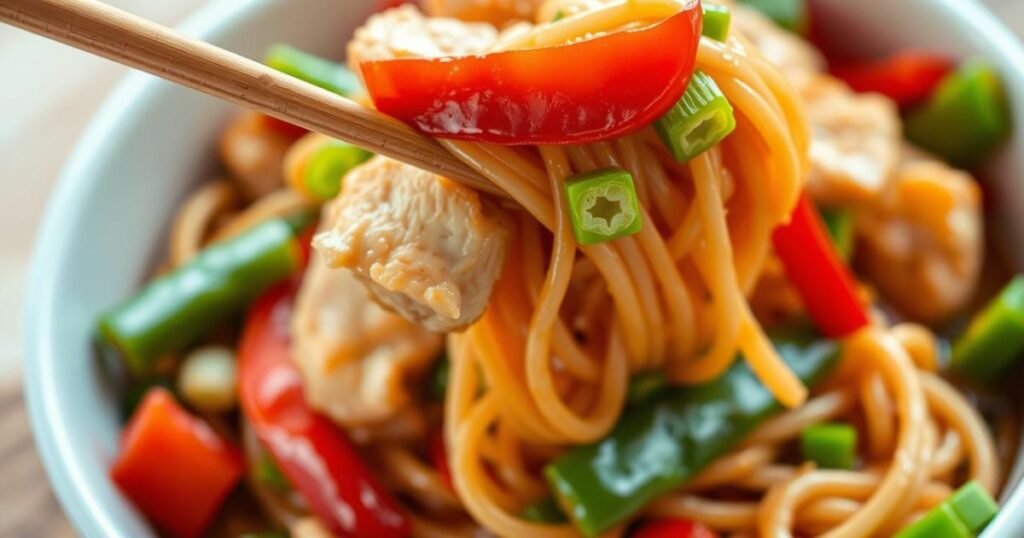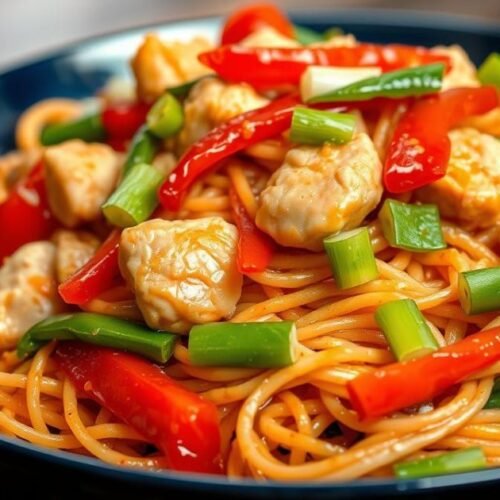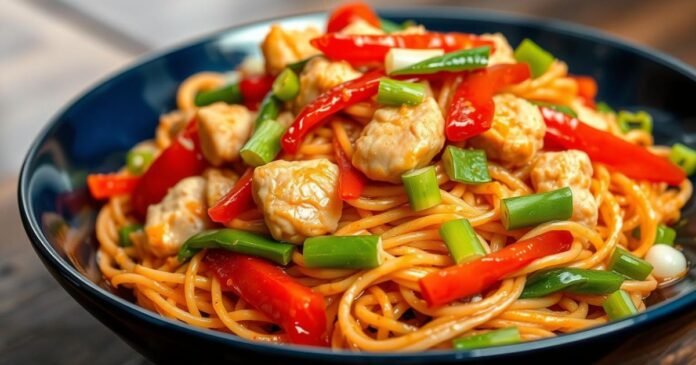Did you know Americans spend over $50 billion on takeout Chinese food each year? That’s about $170 per person annually! But, making restaurant-style dishes at home is much cheaper. I’m excited to share this quick and tasty chicken lo mein recipe. It’s so good, you’ll forget about takeout. The dish is simple: tender chicken, crisp veggies, and noodles in a yummy sauce.
Once a delivery app user, I now prefer making this dish at home. It tastes better, and you know what’s in it. No hidden additives or too much salt! This best chicken lo mein recipe is perfect for a quick dinner or impressing guests. The best part? You likely have most ingredients already.
Ready to cook? Jump to recipe or keep reading for tips on making it restaurant style at home.
Chicken Lo Mein: A Delicious and Quick Weeknight Meal
Don’t order takeout. Try this quick chicken lo mein recipe instead. It has tender chicken, fresh veggies, and yummy noodles. It’s a fast way to enjoy Chinese food at home.
Lo mein is great because you can add any veggies you have. It’s perfect for using up leftovers. The mix of sauce, chicken, and noodles is loved by all.
This recipe is easy to make. You need just a pan, basic ingredients, and 30 minutes. It’s healthier and cheaper than eating out.
What is Chicken Lo Mein?
Chicken lo mein is a Chinese dish with egg noodles, chicken, veggies, and sauce. “Lo mein” means “tossed noodles” in Cantonese. It’s a simple yet tasty dish.
Lo mein noodles are boiled and then tossed with ingredients and sauce. This makes them soft but chewy. It’s a key part of the dish’s appeal.
The sauce for chicken lo mein has soy sauce, sesame oil, brown sugar, garlic, and ginger. These ingredients create a rich, savory flavor.
This dish is loved for its mix of textures and tastes. You get tender chicken, crunchy veggies, chewy noodles, and a sweet sauce. It’s a comforting meal that’s not too heavy.
Difference Between Lo Mein and Chow Mein
Many people confuse lo mein and chow mein. They both use egg noodles but are prepared differently.
The main difference is in how the noodles are cooked:
- Lo Mein: Noodles are boiled and then tossed with ingredients and sauce. This makes the sauce cling to the noodles.
- Chow Mein: Noodles are stir-fried until they’re slightly crispy. This adds a crunchy texture.
In American Chinese restaurants, chow mein has thinner noodles. Lo mein has thicker noodles. Chow mein sauce is lighter, while lo mein sauce is more abundant.
Here’s a quick comparison of these popular noodle dishes:
| Feature | Lo Mein | Chow Mein |
|---|---|---|
| Cooking Method | Boiled then tossed | Stir-fried |
| Noodle Texture | Soft and chewy | Crispy edges |
| Sauce Amount | More sauce | Less sauce |
| Noodle Type | Thicker egg noodles | Thinner egg noodles |
Both dishes are tasty, but lo mein is better for a saucier, chewier noodle. This chicken lo mein recipe is easy to make and tastes like a restaurant dish.
Ready to try this stir fry classic? You’ll be amazed at how easy it is to make authentic flavors at home. The next section will cover the lo mein sauce recipe that makes this dish a hit!

Ingredients for the Perfect Chicken Lo Mein
Creating authentic chicken lo mein starts with the right ingredients. These ingredients should bring flavor and texture to your dish. Most of these items are easy to find, so you won’t need to search for hard-to-find items.
Preparing all ingredients before cooking makes the process easier. This way, your dish comes together quickly. Having everything ready to go is key to a successful meal.
Chicken Lo Mein Sauce
The sauce is what makes chicken lo mein special. A balanced lo mein sauce recipe combines savory, sweet, and umami flavors. These flavors coat every noodle and ingredient perfectly.
My favorite sauce uses light soy sauce for saltiness and dark soy sauce for color and depth. A tablespoon of oyster sauce adds amazing umami flavor. It doesn’t taste fishy at all!
A bit of brown sugar balances the saltiness with sweetness. Sesame oil adds a nutty aroma that’s a hallmark of Chinese cuisine. For some heat, add a teaspoon of sriracha or red pepper flakes.
Whisk all sauce ingredients together in a bowl before cooking. This lets the flavors mix while you prepare the other parts. When you add it to hot noodles and ingredients, the sauce makes the dish glossy and appealing.
Best Noodles for Authentic Lo Mein
Choosing the right noodles is essential for authentic chicken lo mein. Traditional lo mein noodles are made from wheat flour and eggs. They have a rich yellow color and a chewy texture that holds up well to the sauce.
Look for “lo mein noodles,” “Chinese egg noodles,” or “Hokkien noodles” in the international aisle. These noodles come fresh or dried. Fresh noodles cook quickly and have the best texture, but dried ones work well too.
Cook your noodles until they’re al dente – still slightly firm. Overcooked noodles become mushy. Rinse them briefly with cold water after cooking to stop the cooking process and remove excess starch.
If you can’t find specific lo mein noodles, Japanese ramen noodles or linguine pasta can be substitutes. They won’t be the same, but they’ll still taste great.
Vegetables and Protein Options
Chicken lo mein is versatile. You can use boneless skinless chicken breast or try other proteins like chicken thighs, beef, shrimp, tofu, or make it vegetarian.
For chicken, slice the meat into thin, even sized pieces for quick and even cooking. A quick marinade with cornstarch, soy sauce, and oil makes the meat tender and velvety.
Traditional vegetables include cabbage, carrots, and green onions. But feel free to add your favorites! Snow peas add crunch, bell peppers bring color, mushrooms offer earthy flavor, and broccoli adds nutrition and texture.
For a successful stir fry, cut all vegetables into similar-sized pieces. This ensures they cook evenly. Add vegetables in stages, starting with the firmest ones first.
For a healthy chicken lo mein recipe, use more vegetables and less oil. Adding bean sprouts at the end provides fresh crunch, while water chestnuts add unexpected texture. This makes lo mein great for using any vegetables you have!
Step-by-Step Guide to Making Chicken Lo Mein Recipe
Making authentic chicken lo mein is easy with a few key steps. The secret is in preparation. Having everything ready before cooking prevents overcooking and ensures great results.
Here’s how to make a delicious meal in just 30 minutes.
Prepare the Sauce
Start by mixing all your sauce ingredients in a small bowl. You’ll need:
- 3 tablespoons soy sauce
- 1 tablespoon oyster sauce
- 1 tablespoon hoisin sauce
- 1 teaspoon sesame oil
- 1 teaspoon brown sugar
- 1 teaspoon minced garlic
Whisk until well combined and set aside. Having your sauce ready is crucial for authentic flavor and prevents delays.
Marinate the Chicken
Slice your chicken breast into thin strips, about ¼-inch thick. Toss the chicken with:
- 1 teaspoon cornstarch
- 1 tablespoon soy sauce
- 1 teaspoon vegetable oil
Let it sit for 10-15 minutes. This quick marinade makes the chicken tender and juicy.
Prepare the Vegetables
While the chicken marinates, prepare your vegetables. Cut them into similar-sized pieces for even cooking. Julienne your carrots, slice bell peppers into thin strips, and chop broccoli into small florets.
For green onions, separate the white parts (which you’ll cook with the vegetables) from the green parts (which you’ll use as garnish). Having all vegetables prepped and ready in separate piles makes cooking smooth and efficient.
Cook the Noodles
Bring a large pot of water to a boil and cook the noodles according to package instructions. For authentic lo mein, cook them slightly undercooked (al dente) since they’ll finish cooking in the wok.
Once done, drain immediately and rinse with cold water to stop the cooking process. Toss with a teaspoon of sesame oil to prevent sticking. Properly cooked noodles are essential for the perfect texture in your finished dish.
Stir Fry Process
Now comes the exciting part! Heat your wok or large skillet over high heat until it’s very hot. Add 1 tablespoon of vegetable oil and swirl to coat the surface.
Add the marinated chicken in a single layer and let it sear for 30 seconds before stirring. Cook until just done (about 2-3 minutes) then remove to a clean plate.
In the same pan, add another tablespoon of oil if needed, then add your vegetables in stages based on cooking time. Start with the firmest vegetables first:
| Vegetable | When to Add | Cooking Time | Visual Cue | Texture Goal |
|---|---|---|---|---|
| Carrots | First | 2-3 minutes | Slightly softened | Tender-crisp |
| Bell peppers | Second | 1-2 minutes | Bright color | Crisp |
| Broccoli | Second | 2 minutes | Vibrant green | Tender-crisp |
| Snow peas | Third | 1 minute | Bright green | Crisp |
| Green onion (white parts) | Last | 30 seconds | Fragrant | Softened |
Combine Everything
Once your vegetables reach the crisp-tender stage, return the chicken to the pan. Add the cooked noodles and pour the sauce over everything. Toss everything together until well combined and the sauce coats all ingredients evenly.
Allow everything to heat through for just 1-2 minutes. Be careful not to overcook at this stage – you want to maintain the vegetables’ vibrant colors and crisp textures.
Serve and Garnish
Transfer your chicken lo mein to a large serving platter or individual bowls. Sprinkle with the reserved green onion tops and additional sesame seeds if desired.
Serve immediately while hot for the best flavor and texture. The entire cooking process happens quickly, which is why having everything prepped ahead of time is so important for this authentic chicken lo mein recipe.
From start to finish, you can have this impressive dish on the table in about 30 minutes, making it perfect for busy weeknights when you want something delicious without the wait for takeout.

Tips for Making the Best Chicken Lo Mein
Making great chicken lo mein at home is all about a few key techniques. These tips will take your dish from good to amazing. They’re not hard, but they make a big difference in taste and texture.
Start by preparing everything before you heat your wok. Chop ingredients, mix sauce, and have noodles ready. Cooking over high heat in a wok or large skillet adds that smoky flavor found in Chinese restaurants.
Don’t overcrowd your pan. Cook in batches if needed to keep the heat high. Cook noodles a bit under, as they’ll soften when mixed with hot sauce and ingredients.
Slicing Vegetables and Chicken for Even Cooking
Cutting your ingredients the right way is key to a great stir fry. It ensures everything cooks evenly.
For chicken, slice against the grain into thin strips. This makes the chicken tender. For even more tenderness, try velveting the chicken in a mixture of cornstarch, soy sauce, and oil for 15 minutes before cooking.
Vegetables should be cut into uniform pieces for quick cooking. Carrots, cabbage, bell peppers, and broccoli should be cut into thin, bite-sized pieces. Green onions should be cut diagonally into 1-inch segments.
Uniformly sized pieces ensure even cooking and make the dish look appealing. Taking the time to cut everything properly is worth it for a better dish.
Cooking Ingredients Separately for Optimal Texture
Cooking ingredients separately is a secret to achieving restaurant-style texture. It might seem like extra work, but it’s worth it.
Cooking everything together can lead to uneven textures. By cooking separately, each ingredient keeps its best texture.
Start by stir-frying the marinated chicken until just cooked. Then, remove it from the pan. This prevents the chicken from becoming tough.
Next, stir-fry vegetables in stages. Start with carrots and end with green onions. Only combine everything when all components are perfectly cooked.
This method ensures your chicken is tender, vegetables are crisp-tender, and noodles are chewy. It’s a small step that makes your dish authentic and professional-tasting.
Boiling Noodles According to Package Instructions
Cooking your lo mein noodles right is crucial for the perfect texture. There are a few important things to remember when cooking noodles.
Always follow the package instructions for cooking time. Aim for al dente, as the noodles will continue cooking in the stir-fry.
Use plenty of water in a large pot to prevent noodles from sticking. Adding a small amount of oil to the boiling water can also help prevent sticking. After cooking, rinse the noodles under cold water to stop the cooking process and remove excess starch.
Fresh lo mein noodles cook much faster than dried varieties. They might only need a quick blanch in boiling water for 1-2 minutes. Properly cooked noodles should be pliable but still slightly chewy, providing that satisfying texture that makes lo mein so crave-worthy.
Variations and Substitutions for a Healthier Dish
Homemade chicken lo mein is versatile and can be adapted to fit dietary needs. Making it healthier is easy without sacrificing flavor.
For a lower-carb option, use zucchini “zoodles” or spaghetti squash instead of noodles. Whole wheat lo mein noodles offer more fiber than traditional varieties.
To reduce sodium, use low-sodium soy sauce and chicken broth in your sauce. Adding more colorful vegetables like red bell peppers, snow peas, broccoli, and spinach boosts nutrition.
| Traditional Ingredient | Healthier Substitution | Benefit | Taste Impact |
|---|---|---|---|
| Regular lo mein noodles | Whole wheat lo mein noodles | More fiber, lower glycemic impact | Slightly nuttier flavor, similar texture |
| Regular soy sauce | Low-sodium soy sauce | Reduced sodium content | Slightly less intense flavor, easily adjusted |
| Brown sugar | Monk fruit sweetener | Zero calories, no blood sugar impact | Similar sweetness, no aftertaste |
| Boneless chicken breast | Tofu or tempeh | Plant-based protein, lower fat | Different texture, absorbs flavors well |
| Vegetable oil | Avocado oil or cooking spray | Healthier fats or reduced oil content | Neutral flavor, similar cooking results |
To reduce sugar, use less brown sugar or substitute with monk fruit. Rice noodles are a gluten-free option, though they have a different texture.
Make the dish plant-based by using tofu, tempeh, or mushrooms. Reducing oil is easy with a non-stick pan and a small amount of oil or cooking spray.
These adjustments let you customize the dish to your liking while keeping the delicious lo mein flavors.

Conclusion
Making chicken lo mein at home gives you control over the flavor. You can make it taste like your favorite takeout, but with ingredients you know. Plus, this recipe is quick, ready in just 30 minutes.
This recipe is great because it’s flexible. Want to use green beans instead of snow peas? Go for it. Add more red pepper flakes for extra spice. Cooking each ingredient separately keeps everything perfect.
Your homemade chicken lo mein will be a hit. It’s all about the balance of savory sauce, tender chicken, and noodles. You might even prefer it over your favorite restaurant’s version.
Leftovers can be stored for up to three days in an airtight container. A splash of water can revive the noodles. This dish often tastes better the next day, as the flavors blend together.
Ready to make amazing Chinese food at home? This simple recipe shows you can make delicious meals without spending hours cooking. Just use fresh ingredients, a hot wok, and your love for great food!
FAQ – Lo Mein
What’s the difference between lo mein and chow mein?
Lo mein noodles are boiled and then tossed with sauce. Chow mein noodles are parboiled and stir-fried until crispy. Lo mein is saucier and softer, while chow mein is crisper.
Can I make chicken lo mein ahead of time?
Yes! You can store chicken lo mein in the fridge for up to 3 days. Keep it in an airtight container. Reheat with a bit of water or broth to refresh the sauce. The flavors get better after a day.
What can I substitute for oyster sauce?
Use a mix of soy sauce and hoisin sauce (2:1 ratio) if you don’t have oyster sauce. For a vegetarian option, try vegetarian oyster sauce or more soy sauce with a bit of brown sugar.
Can I use different vegetables in my lo mein?
Absolutely! You can use snow peas, bok choy, broccoli, mushrooms, and more. Just cut them into similar sizes for even cooking.
What type of noodles should I use for authentic lo mein?
Traditional lo mein uses Chinese egg noodles. But you can also use spaghetti, linguine, or ramen noodles. For a healthier option, try whole wheat or zucchini noodles.
How do I prevent my noodles from sticking together?
Cook noodles until just al dente, then rinse them under cold water. This stops cooking and removes excess starch. Toss with sesame oil to prevent sticking.
Can I make this recipe with other proteins?
Yes! You can use beef, pork, shrimp, tofu, or skip the protein for more veggies. Cooking times may vary based on your protein choice.
What’s the secret to restaurant-style lo mein sauce?
The secret is balancing sweet, savory, and umami flavors. Use light and dark soy sauce, oyster sauce, brown sugar, and sesame oil. Adjust to taste for your perfect sauce.

Easy Chicken Lo Mein Recipe
Ingredients
- Chicken Lo Mein Sauce
- 3 tablespoons soy sauce
- 1 tablespoon oyster sauce
- 1 tablespoon hoisin sauce
- 1 teaspoon sesame oil
- 1 teaspoon brown sugar
- 1 teaspoon minced garlic
- Chicken Marinade
- 1 teaspoon cornstarch
- 1 tablespoon soy sauce
- 1 teaspoon vegetable oil
- Other Ingredients
- Boneless skinless chicken breast sliced into thin strips
- Assorted vegetables e.g., carrots, bell peppers, broccoli, snow peas, green onions
- Lo mein noodles or Chinese egg noodles
- 1–2 tablespoons vegetable oil for stir-frying
- Sesame seeds optional garnish
Instructions
- Prepare the Sauce
- Whisk together soy sauce, oyster sauce, hoisin sauce, sesame oil, brown sugar, and minced garlic in a small bowl. Set aside.
- Marinate the Chicken
- Slice chicken into ¼-inch strips. Toss with cornstarch, soy sauce, and vegetable oil. Let sit for 10–15 minutes.
- Prepare the Vegetables
- Cut vegetables into even pieces. Separate white and green parts of green onions.
- Cook the Noodles
- Boil noodles per package instructions to al dente. Rinse with cold water and toss with sesame oil.
- Stir Fry Process
- Heat wok/skillet until very hot.
- Add oil, then chicken. Sear 30 seconds before stirring. Cook 2–3 minutes. Remove chicken.
- Add more oil if needed. Stir fry vegetables in stages:
- Carrots (2–3 minutes)
- Bell peppers, broccoli (1–2 minutes)
- Snow peas (1 minute)
- Green onion whites (30 seconds)
- Combine Everything
- Return chicken, add noodles, and pour sauce. Toss until evenly coated and heated through (1–2 minutes).
- Serve and Garnish
- Serve hot. Garnish with green onion tops and sesame seeds if desired.
Notes
- Prepare all ingredients before cooking to avoid overcooking.
- Use a hot wok for smoky, restaurant-style flavor.
- Slice chicken and vegetables evenly for uniform cooking.
- Cook each ingredient separately for best texture.
- Rinse noodles with cold water and toss in sesame oil to prevent sticking.
- Customize with other proteins like shrimp, beef, or tofu.
- Store leftovers up to 3 days. Reheat with water to refresh sauce.

